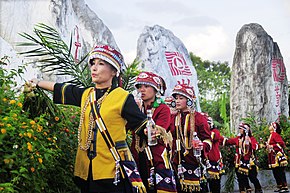Sakizaya
The Sakizaya ( 撒奇萊雅 , Sāqíláiyǎ ), also known as Sakidaya, Sakuzaya or Sakiraya , are one of the indigenous peoples of Taiwan . According to official statistics, the number of Sakizaya in August 2019 was 972 people. Most of them live in Hualien County in eastern Taiwan.
Many Sakizaya were killed in the 1878 Takubuwan battle against Qing attackers. The survivors joined the Americans and were classified as Americans in later statistical surveys. Since 2007, the Sakizaya have been officially recognized as an independent ethnic group by the government of Taiwan .
geography
The Sakizaya live long-established in the area of the mountain Qilaishan ( Chinese 奇萊 山 , Pinyin Qílái shān ) up to the coast of the Hualiens. They were the largest indigenous people of the Hualien coastal plain (Qilai plain) in the 17th century. The name of the Qilai plain and the Qilai mountain range come from the Sakizaya language.
Currently, the Sakazaya are mainly divided into five communities in Hualien County : Sakul and Takubuwan in Hualien City , Hupu in Xincheng Township, Maibul in Ruisui Township, and Kaluluwan in Fengbin Township . Part of the Sakizaya also live in Taoyuan .
language
The Sakizaya language, also called Sakizaya, was only used as a dialect of Amisian after the Takubuwan battle and was recognized as a separate East Formosa language by the Center of Aboriginal Studies at Chengchi National University in 2002 , but it is related to Amisish. Sakizaya uses the ISO-639-3 code [szy] and forms the Ami language as a sub-language with the sister language, pure Ami [ami].
history
In 1636 the Sakizaya were registered on Formosa by the Spanish colonizers. At the time, the north and northeast of Taiwan were under Spanish rule and divided into three provinces, including the Sakizaya settlement area.
During the Dutch colonial period from 1624 to 1662 there was contact between the Sakizaya and the Dutch. In 1638 an expedition of the Dutch East India Company explored the east of Formosa.
During the time of the Qing rule from 1683, the Sakizaya became the dominant people of the Qilay plain (the plain around today's city of Hualien). In the 19th century, the Qing administration increasingly tried to bring the east of the island of Taiwan under their control. There were repeated clashes with the Sakizaya.
On June 18, 1878, there was an open battle between armed Sakizaya and the Kavalan and Qing troops allied with them in the so-called Takobowan battle (or Takubuwan battle; in the Sakizaya language: Takubuwa a kawaw ; in Kavalan: Lanas na Kabalaen ; Chinese 加 禮 宛 戰役 ). This event ended with many Sakizaya killed. After the battle, Chief Komod Pazik and his wife Icep Kanasaw were killed by the Qing Army using the Lingchi torture method . The survivors hid their own culture and language and joined the Americans to avoid persecution. According to official historiography, the Sakizaya people were considered completely wiped out after the battle.
After the lost Takubuwan battle, the Sakizaya hid among the Americans. They were classified as Amis by the Japanese government (1895-1945) and called Kiray-Amis . During this time there were no more conflicts between the Sakizaya and the Japanese colonial power, while other indigenous peoples repeatedly revolted against Japanese rule. Even at the time of the Kuomintang sole rule (1945–1989 / 90), the Sakizaya were officially considered to be Americans.
On January 17, 2007, the Sakizaya were officially recognized as a separate ethnic group by the Republic of China.
literature
Shiun-wey Huang: Cultural Construction and a New Ethnic Group Movement: The Name Rectification Campaign and the Fire God Ritual of the Sakizaya in Eastern Taiwan . Ed .: Institute for Ethnology, Academia Sinica, Taiwan. S. 62–80 (English, PDF ).
Individual evidence
- ↑ 原住民 人口 數 統計 資料 ("Population statistics of the indigenous people"). Council of Indigenous Peoples, Taiwan, accessed September 14, 2019 (Traditional Chinese).
- ↑ a b c Taiwan recognizes 'lost' people. BBC News, January 19, 2007, accessed November 8, 2018 .
- ↑ 奇萊 平原 古 聚落 展 地名 翻譯 惹 微詞 2017-03-02 TITV 原 視 新聞 (Exhibition about the Qilai plain and the ancient tribes). TITV News from March 2, 2017 on YouTube, accessed November 9, 2018 (Chinese).
- ↑ Sakizaya becomes the 13th indigenous group. Taiwan Journal, January 26, 2007, archived from the original ; accessed on November 9, 2018 (English).
- ↑ Dennis Engbarth: Sakizaya becomes Taiwan's 13th native tribe. Taiwan News, January 18, 2007, accessed November 9, 2018 .

